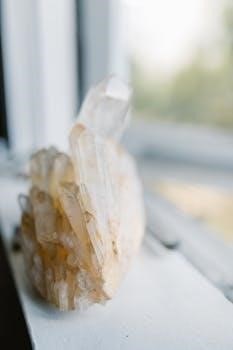Chakra Chart PDF⁚ An Overview
A Chakra Chart PDF offers a visual guide to the seven chakras, energy centers along the spine. These charts typically include each chakra’s location, color, and associated meanings. They serve as a learning tool for understanding the chakra system. These are useful for anyone exploring energy and wellness.
Chakras, originating from Sanskrit, are described as spinning wheels or vortexes of energy within the body. They are fundamental to understanding the flow of prana, or life force, throughout our system. These energy centers are not physical but rather exist in the astral body, influencing our physical, emotional, and spiritual well-being. Each of the seven main chakras is associated with specific colors, locations along the spine, and functions. These energy hubs are thought to regulate different aspects of consciousness, health, and our connection to the world around us. Understanding the chakras allows us to explore our inner landscape, recognize where energy may be blocked, and find ways to restore balance. The chakra system provides a framework for personal growth and self-awareness. It encourages us to delve into our energetic anatomy for a more holistic view of ourselves. The concept of chakras is an integral part of yogic and spiritual traditions, offering insights into the human experience.
Chakra Locations Along the Spine
The seven primary chakras are positioned along the spine, from the base to the crown of the head, forming a vertical line of energy centers. The root chakra, or Muladhara, sits at the base of the spine, near the tailbone, grounding us to the earth. Moving upwards, the sacral chakra, or Svadhisthana, resides in the lower abdomen, about two inches below the navel, governing creativity and emotions. The solar plexus chakra, or Manipura, is found in the upper abdomen, just below the chest, related to personal power. The heart chakra, or Anahata, is located in the center of the chest, near the heart, associated with love and compassion. The throat chakra, or Vishuddha, is positioned at the base of the throat, connected to communication. The third eye chakra, or Ajna, is situated in the center of the forehead, between the eyebrows, relating to intuition. Finally, the crown chakra, or Sahasrara, is located at the top of the head, representing spiritual connection. The locations of these chakras are crucial for understanding their influence on our overall well-being.
Root Chakra (Muladhara)⁚ Location and Meaning
The Root Chakra, also known as Muladhara, is the first of the seven main chakras, located at the base of the spine, near the tailbone. This chakra serves as the foundation of our energetic system, grounding us to the earth and providing a sense of stability and security. Its primary function is to connect us to our physical body and the material world, ensuring our basic needs are met. The root chakra is associated with the color red, symbolizing strength, physical energy, and vitality. It is also connected with the earth element, emphasizing its role in grounding and providing a sense of rootedness. A balanced root chakra fosters feelings of safety, security, and confidence in our ability to survive and thrive. When imbalanced, it can manifest as feelings of anxiety, fear, or insecurity. Understanding the location and meaning of the root chakra is essential for overall well-being, as it forms the basis for all other chakras. The root chakra’s health is vital for a stable life.
Sacral Chakra (Svadhisthana)⁚ Location and Function
The Sacral Chakra, known as Svadhisthana, is the second of the seven chakras, situated in the lower abdomen, approximately two inches below the navel. This energy center governs our emotions, creativity, and sensuality. The sacral chakra is associated with the color orange and the element of water, reflecting its connection to fluidity, change, and the flow of feelings. It plays a vital role in our capacity to experience pleasure, joy, and intimacy. A balanced sacral chakra allows for healthy emotional expression, creativity, and a sense of abundance and well-being. It also influences our ability to connect with others and form intimate relationships. When imbalanced, it can lead to emotional instability, a lack of creativity, or an overindulgence in sensual pleasures. The sacral chakra is essential for our ability to embrace life fully and connect with our passions and desires. It is the center of our creative energy and emotional balance.

Solar Plexus Chakra (Manipura)⁚ Location and Significance
The Solar Plexus Chakra, or Manipura, is the third chakra, positioned in the upper abdomen, just below the chest. Specifically, it is located between the navel and the bottom of the rib cage. This chakra is the center of personal power, self-esteem, and confidence, and is often associated with the color yellow. Manipura is also linked to our willpower, assertiveness, and the ability to take control of our lives. It is the source of our inner fire, driving our actions and decisions. A balanced solar plexus chakra allows us to feel self-assured, capable, and empowered. It helps us to establish healthy boundaries and make confident choices. An imbalance in this chakra can lead to feelings of insecurity, low self-esteem, or an excessive need for control. Physically, it’s connected to the digestive system, and imbalances can manifest as digestive problems or issues with the liver. The Solar Plexus Chakra is crucial for developing a strong sense of self and navigating the world with confidence.
Chakra Colors and Their Meanings
Each of the seven chakras is associated with a specific color, which holds symbolic meaning and reflects the energy of that particular chakra. The Root Chakra, located at the base of the spine, is associated with the color red, symbolizing grounding, stability, and physical energy. The Sacral Chakra, situated in the lower abdomen, is represented by orange, reflecting creativity, emotions, and pleasure. Moving upward, the Solar Plexus Chakra, found in the upper abdomen, is linked to yellow, representing personal power, confidence, and self-esteem. The Heart Chakra, at the center of the chest, is associated with green (or sometimes pink), symbolizing love, compassion, and healing. The Throat Chakra, in the throat region, is represented by blue, reflecting communication, truth, and self-expression. The Third Eye Chakra, located in the center of the forehead, is linked to indigo, symbolizing intuition, wisdom, and inner vision. Finally, the Crown Chakra, at the top of the head, is associated with violet or white, representing spiritual connection, enlightenment, and universal consciousness. Understanding these color associations can provide deeper insights into each chakra’s function and purpose.
Chakra Imbalances and Their Effects
Chakra imbalances can manifest in various ways, impacting physical, emotional, and mental well-being. When the Root Chakra is imbalanced, individuals may experience feelings of insecurity, anxiety, or disconnection from the physical world. A Sacral Chakra imbalance can lead to emotional instability, lack of creativity, or issues with intimacy. An imbalance in the Solar Plexus Chakra might manifest as low self-esteem, lack of confidence, or digestive problems. An imbalanced Heart Chakra can result in difficulties with giving and receiving love, feelings of isolation, or emotional pain. A Throat Chakra imbalance might present as difficulties in expressing oneself, fear of speaking up, or communication issues. Imbalances in the Third Eye Chakra can lead to a lack of intuition, difficulty in focusing, or feelings of confusion. Finally, a Crown Chakra imbalance may manifest as a lack of spiritual connection, feelings of isolation, or a sense of meaninglessness. Recognizing these symptoms can be a first step towards addressing chakra imbalances and restoring harmony within the body and mind.
Balancing Chakras⁚ Techniques and Practices
Several techniques and practices can help balance the chakras and restore the flow of energy. For the Root Chakra, grounding exercises like walking barefoot on the earth or spending time in nature can be beneficial. To balance the Sacral Chakra, activities that promote creativity, such as painting or dancing, and connecting with water can be effective. The Solar Plexus Chakra can be balanced through practices that boost self-esteem, like setting personal goals or affirmations. Heart Chakra balance can be enhanced by practicing self-love, forgiveness, and acts of compassion. To support the Throat Chakra, speaking your truth with kindness and practicing active listening are helpful. The Third Eye Chakra can be balanced through meditation, visualization, and spending time in quiet contemplation. Finally, spiritual practices such as prayer, meditation, and connecting with something bigger than oneself can help balance the Crown Chakra. Additionally, yoga poses, specific mantras, and sound frequencies can be used to stimulate and balance the energy centers.

Chakra Chart as a Learning Tool
A chakra chart serves as an excellent visual aid for understanding the complex system of energy centers within the body. For beginners, it offers a clear overview of each chakra’s location along the spine, from the base to the crown. The chart typically includes the associated colors, which provide a quick reference for each chakra’s unique energy vibration. Furthermore, symbols often accompany the chakras, representing their specific functions and connections to the elements. These charts also highlight the meaning of each chakra, helping individuals to understand its role in their overall well-being and consciousness. This tool is particularly useful when learning about the different aspects each chakra governs such as emotions, personal power, communication, and spiritual awareness. By exploring a chakra chart, users gain a foundational understanding of how to balance energy flow through the body and promote harmony. It’s a valuable resource for both personal exploration and teaching purposes.

Chakra Meditation and Its Benefits
Chakra meditation is a powerful practice that focuses on balancing and activating the body’s energy centers. By directing your attention to each chakra, typically along the spine, you can encourage the flow of prana, or life force energy. The benefits of chakra meditation are numerous, including improved emotional balance, enhanced self-awareness, and reduced stress. This type of meditation often involves visualization techniques, where you imagine the specific color associated with each chakra, and sometimes the use of mantras or sounds. It is believed that consistent chakra meditation can help to release blockages, allowing energy to flow freely, thus promoting physical and emotional health. Furthermore, it can deepen your spiritual connection and increase your sense of well-being. Chakra meditation also serves as a tool for personal growth, fostering a more harmonious relationship between mind, body, and spirit. Regularly practicing chakra meditation supports overall wellness and self-discovery.
Comprehensive Chakra Information on a PDF
A comprehensive Chakra PDF provides detailed insights into the seven primary chakras, serving as a thorough guide for understanding these energy centers. Such a PDF typically encompasses various aspects, including each chakra’s Sanskrit name, its location along the spine, associated color, and its specific function. It often includes information on the emotional and physical effects of balanced and imbalanced chakras. Furthermore, a comprehensive PDF might explore practices for balancing these energy centers, such as specific yoga poses, meditation techniques, and affirmations. It may also delve into the symbolic meaning of each chakra and its connection to elements like earth, water, fire, air, and ether. These resources can be invaluable for both beginners and experienced practitioners seeking a deeper understanding of their energetic body. The PDF may also contain visual aids, like diagrams of the chakra locations and their respective symbols. It is designed to be a complete reference for self-study and personal growth.

